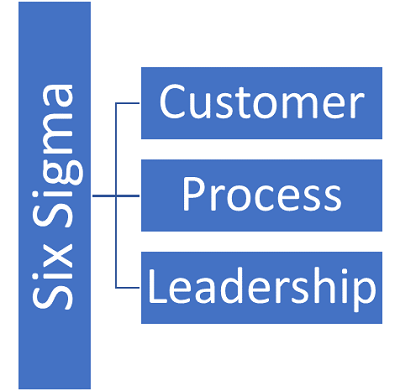There are three key components of quality: Customer, Process, and Leadership. Everything we do to remain a world-class quality company focuses on these three essential elements.Higher quality leads to Satisfied customer and ultimately higher profits.Customer orientation is a desire to produce goods & services that the customer want, and they will be happy to purchase.

Focus on Customer
- Delighting Customers:
Customers are the center of Business: In Six Sigma, customer focus is a top priority. Six Sigma approach- Improve performance, reliability, competitive prices, on-time delivery, service, clear and correct transaction processing and more. At every point that influences customer perception, we know that just being good is not enough. Delighting our customers is a requirement. Because if we don't do it, someone else will!
- Process Improvement:
To achieve success, Quality is accuracy: wonders are created when everyone is dedicated to doing their work perfectly. Quality Needs us to look at our business from the customer's perception, not ours; customer satisfaction is a must. In other words, we must look at our processes from the outside-in. By understanding the business lifecycle from the customer's needs and processes, we can find out what they are seeing and feeling. With this knowledge, we can identify areas where we can add substantial value or improvement from their perspective. The idea is to achieve command over process like Designing, Improving efficiency and enhancing customer satisfaction.
- Leadership Commitment:
Organizations with Six Sigma approach needs to shift to one that includes a methodical approach to problem-solving and a pro-active attitude among employees. Successful Six Sigma programs also contribute to the overall sense of self-importance of the organization’s employees. People create good results. Involving all employees is essential to Six Sigma quality approach. The organization is committed to providing opportunities and incentives for employees to focus their talents and energies on satisfying customers.
Following are the Training Courses:
-
Quality Overview Seminars: basic Six Sigma awareness.
-
Team Training: Basic tool introduction to equip employees to participate on Six Sigma teams.
-
Master Black Belt, Black Belt, and Green Belt Training: Quality in-depth training that includes high-level statistical tools, basic quality control tools.
-
Design for Six Sigma (DFSS) Training: Prepare teams for the use of statistical tools to design it right the first time. Six Sigma strives for zero defect. It agrees to only 3.4 defects per million opportunities for each product or service transaction.
Note:
1.Quality is the responsibility of every employee. Every employee must be involved, motivated and knowledgeable if we want to be successful.
2. Many people thought that Six Sigma works for high-level companies only as they produce in volumes and have thousands of employees. This belief is false, and Six Sigma can be successfully applied to medium and small businesses and even companies with fewer than ten employees can also apply six sigma.
